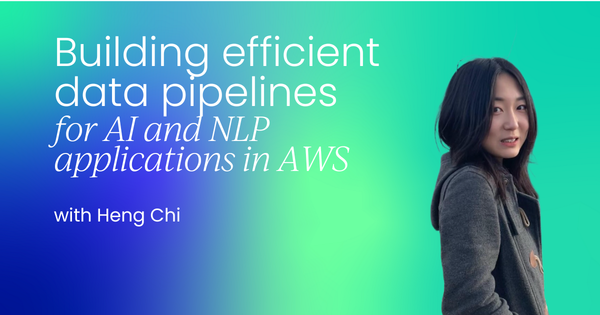Advanced AI and NLP applications are in great demand in today’s modern world, wherein most businesses rely on data-driven insights and automation of business processes.
All applications of AI or NLP have a requirement for a data pipeline that can ingest data, process it, and provide output for training, inference, and subsequent decision making at a large scale. AWS is taken to be the cloud standard with its scalability and efficiency for building these pipelines.
In this article, we will discuss designing a high-performance data pipeline using only basic AWS services like Amazon S3, AWS Lambda, AWS Glue, and Amazon SageMaker for AI and NLP applications.
This article discusses building a high-performance data pipeline for AI and NLP applications using core AWS services such as Amazon S3, AWS Lambda, AWS Glue, and Amazon SageMaker.
Why AWS for data pipelines?
AWS is the most preferred choice for building data pipelines because of its strong infrastructure, rich service ecosystem, and seamless integration with ML and NLP workflows. Azure, Google Cloud, and AWS also outperform open source tools like Apache Suite in terms of ease of use, operational reliability, and integration. Some of the benefits of using AWS are:
Scalability
AWS would automatically scale up or down because of its elasticity, hence always assuring high performance irrespective of the volume of data. Though Azure and Google Cloud provide features for scaling, the auto-scaling options available in AWS are more granular and customizable, hence providing finer control over resources and costs.
Flexibility and integration
AWS has various services that best fit the components of a data pipeline, including Amazon S3 for storage, AWS Glue for ETL, and Amazon Redshift for data warehousing. More so, seamless integrations with AWS ML services like Amazon SageMaker and NLP models make it perfect for AI-driven applications.
Cost efficiency
AWS’s pay-as-you-go pricing model ensures cost-effectiveness for businesses of all sizes. Unlike Google Cloud, which sometimes has a higher cost for similar services, AWS provides transparent and predictable pricing. Reserved Instances and Savings Plans further enable long-term cost optimization.
Reliability and global reach
AWS is built on extensive global infrastructure comprising several data centers across the world's regions, ensuring high availability and low latency for users spread worldwide.
Whereas Azure also commands a formidable presence around the world, the sheer reliability and experience in operations favor AWS. AWS, moreover, provides compliance with a broad set of regulatory standards and hence finds a better proposition in healthcare and finance.
Security and governance
AWS provides default security features, including encryption, identity management, and more, to keep your data safe during the entire data pipeline. AWS provides AWS Audit Manager and AWS Artifact for maintaining compliance-much more advanced compared to what is available on other platforms.
So, by choosing AWS, organizations gain access to a scalable and reliable platform that simplifies the process of building, maintaining, and optimizing data pipelines. Its rich feature set, global reach, and advanced AI/ML integration make it a superior choice for both traditional and modern data workflows.

Some Key AWS services to use for data pipelines
Before discussing architecture, it is worth listing some key AWS services that almost always form part of a data pipeline for artificial intelligence or NLP applications:
- Amazon S3 (Simple Storage Service): A kind of object storage that can scale to hold enormous amounts of unstructured data. In general, S3 acts like an entry point or an ingestion layer where raw datasets are normally stored.
- Amazon Kinesis: A service for real-time data streaming, allowing ingesting and processing streams of data in real time. Applications requiring live data analysis can apply this.
- AWS Lambda: A serverless compute service that allows you to run code without provisioning servers. Lambda is very helpful in event-driven tasks, for example: data transformation or triggering a workflow when newer data arrives.
- AWS Glue: A fully managed extract, transform, and load (ETL) service that prepares and transforms data automatically for analysis. Glue can also act as a catalog for locating and organizing the data stored within various AWS services.
- Amazon SageMaker: This is Amazon's fully integrated service of machine learning, which greatly simplifies the process through which developers build, train, and deploy AI models. SageMaker works in conjunction with other AWS data pipeline services, providing an easier way to operationalize AI and NLP applications. As a result, it has become much easier for developers, scientists, and engineers to build integrated AI and NLP applications through SageMaker's single-click workflows.
Designing an efficient data pipeline for AI and NLP
A structured approach is paramount in designing a really efficient data pipeline for AI/NLP applications. Further below are steps regarding how an effective pipeline can be designed on AWS.
Step 1: Ingesting data
Normally, the ingestion of data is the first activity in any data pipeline. AWS supports various methods of data ingesting, depending on the source and nature of the data.
In general, data can be unstructured, like text, images, or audio, for example. In that case, it usually would have Amazon S3 as a starting point for data storage. On the other side, Amazon Kinesis would work just fine for real-time data ingesting that may emanate from sensors, social media, or streaming platforms.
Most of the time, this is something that forms a starting point of your big data pipeline, tasked with collecting and processing huge amounts of data in real time before sending it further down the pipeline.
Step 2: Data transformation and preparation
Once ingested, the data should be prepared and transformed into a format appropriate for AI and NLP models. AWS has the following tools for this purpose:
AWS Glue: It is the ETL service that makes the process of data extraction from one storage to another much smoother and straightforward.
In cleaning and preprocessing text data as preparation for several NLP tasks, such as tokenization, sentiment analysis, or entity extraction, this tool can be applied. AWS Lambda is another very useful tool for performing event-driven transformations.
The latter automatically preprocesses data in S3 for newly uploaded objects, which could mean filtering, format conversion, or enriching with additional metadata. Several applications of AI in real-time prediction can be directly fed into Amazon SageMaker for training or inference.
Running the batch jobs periodically through the scheduling of AWS Glue and Lambdas will ensure that data is always up to date.
Step 3: Model training and inference
Following data preparation, this is where the actual training of AI and NLP models happens. Amazon SageMaker is a comprehensive environment for machine learning to rapidly build, train, and deploy models.
Thus, one can now use SageMaker in this regard to support popular ML frameworks like TensorFlow, PyTorch, and scikit-learn, which directly integrates with S3 for access to the training data.
Similar to specific tasks involving NLP, such as sentiment analysis, machine translation, and named entity recognition, there is a built-in solution within SageMaker for natural language processing. Seamlessly train your NLP models on SageMaker and scale up the training on several instances for faster performance.
Finally, SageMaker deploys the trained model to an endpoint that can then be used to make predictions in real time. These results can then be written back to S3 or even to a streaming service like Amazon Kinesis Data Streams for further processing.
Step 4: Monitoring and optimization
The proper workflow is to keep a check on the performance-security of both the data pipeline and the models. AWS provides some sets of monitoring tools, such as Amazon CloudWatch, to track metrics, log errors, and trigger alarms in case of something wrong happening with the pipeline.
You can also use Amazon SageMaker Debugger and Amazon SageMaker Model Monitor to monitor the performance of ML models in production. These allow you to detect anomalies, monitor for concept drift, and otherwise make sure your model keeps performing as expected over time.
Step 5: Integrating with data analytics for fast query and exploration
Once your data pipeline is processing and producing outputs, enabling efficient querying and exploration is key to actionable insights. This ensures not only that your data is available but also accessible in a form that allows for rapid analysis and decision-making.
AWS provides robust tools to integrate analytics capabilities directly into the pipeline:
- Amazon OpenSearch Service: to offer full-text search, data visualization, and fast querying over large datasets, something important, especially when analyzing logs or results originating from NLP tasks.
- Amazon Redshift: Run complex analytics queries on structured data at scale. Redshift's powerful SQL capabilities allow seamless exploration of processed datasets, enabling deeper insights and data-driven decisions.
This integration pipes the transformed data out to immediate exploration in real-time and/or to downstream analytics, giving a complete view of outputs from your pipeline, which brings us to the next section, where we’ll explore best practices for building efficient and scalable AWS data pipelines.

Best practices for building AWS data pipelines
Leverage serverless architecture
You can do this by using AWS Lambda and AWS Glue to simplify your architecture by reducing the overhead involved in the management of servers. In that respect, a serverless architecture will ensure that your pipeline scales seamlessly, utilizing only those resources actually used. Thus, it becomes optimized for performance and cost.
Automate data processing
Leverage event-driven services like AWS Lambda to have events triggered automatically for the transformation and processing of incoming data. This ensures minimum human intervention and that the pipeline is up and running smooth, without delays.
Optimize storage costs
Utilize different storage classes in Amazon S3, such as S3 Standard, S3 Infrequent Access, and S3 Glacier, to balance cost and access needs. For infrequently accessed data, use Amazon S3 Glacier to store the data at a lower cost while ensuring that it's still retrievable when necessary.
Implement skey
Ensure that your data pipeline adheres to security and compliance standards by using AWS Identity and Access Management (IAM) for role-based access control, encrypting data at rest with AWS Key Management Service (KMS), and monitoring network traffic with AWS CloudTrail.
Security and compliance are key in AWS data pipelines, considering the present landscape where data breaches are rampant, coupled with growing regulatory scrutiny.
Therefore, this may involve sensitive information such as personally identifiable information, financial records, or healthcare data that demands strong security measures against unauthorized access to protect against possible monetary or reputational damage.
AWS KMS ensures data at rest is encrypted, making it unreadable even if compromised, while AWS IAM enforces role-based access to restrict data access to authorized personnel only, reducing the risk of insider threats.
Compliance with regulations like GDPR, HIPAA, and CCPA is crucial for avoiding fines and legal complications, while tools like AWS CloudTrail help track pipeline activities, enabling quick detection and response to unauthorized access or anomalies.
Beyond legal requirements, secure pipelines foster customer trust by showcasing responsible data management and preventing breaches that could disrupt operations. A robust security framework also supports scalability, keeping pipelines resilient and protected against evolving threats as they grow.
It is important to keep prioritizing security and compliance so that organizations not only safeguard data but also enhance operational integrity and strengthen customer confidence.
Conclusion
AWS is a strong choice for building AI and NLP data pipelines primarily because of its intuitive user interface, robust infrastructure, and comprehensive service offerings.
Services like Amazon S3, AWS Lambda, and Amazon SageMaker simplify the development of scalable pipelines, while AWS Glue streamlines data transformation and orchestration. AWS’s customer support and extensive documentation further enhance its appeal, making it relatively quick and easy to set up pipelines.
To advance further, organizations can explore integrating AWS services like Amazon Neptune for graph-based data models, ideal for recommendation systems and relationship-focused AI.
For advanced AI capabilities, leveraging Amazon Forecast for predictive analytics or Amazon Rekognition for image and video analysis can open new possibilities. Engaging with AWS Partner Network (APN) solutions can also offer tailored tools to optimize unique AI and NLP workflows.
By continuously iterating on architecture and using AWS’s latest innovations, businesses can remain competitive while unlocking the full potential of their data pipelines.
However, AWS may not always be the best option depending on specific needs, such as cost constraints, highly specialized requirements, or multi-cloud strategies. While its infrastructure is robust, exploring alternatives like Google Cloud or Azure can sometimes yield better solutions for niche use cases or integration with existing ecosystems.
To maximize AWS's strengths, organizations can leverage its simplicity and rich service catalog to build effective pipelines while remaining open to hybrid or alternative setups when business goals demand it.



 Follow us on LinkedIn
Follow us on LinkedIn




